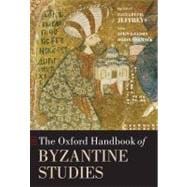
Note: Supplemental materials are not guaranteed with Rental or Used book purchases.
Purchase Benefits
What is included with this book?
| The Discipline | |
| Byzantine Studies as an academic discipline | |
| Instrumenta: tools for the study of the discipline | |
| Primary sources | |
| Chronology and dating | |
| Weights and measures | |
| Archaeology | |
| Critical approaches to art history | |
| Iconography | |
| Literary criticism | |
| Textual criticism | |
| Lexicography and electronic textual resources | |
| Palaeography, codicology, diplomatic | |
| Documents: imperial chrysobulls | |
| Documents: Athos | |
| Documents: Venetian Crete | |
| Epigraphy | |
| Sigillography | |
| Numismatics | |
| Prosopography | |
| Dendrochronology | |
| Brickstamps | |
| Topography of Constantinople | |
| The Physical World | |
| Landscape, Land Use and the Environment | |
| The political geography of the Byzantine world | |
| Geographical surveyGeoffrey Greatrex | |
| Political-historical survey | |
| Communications (roads, bridges, etc.) | |
| Dionysios Stathakopoulos | |
| Population, demography and disease | |
| Settlement | |
| Towns and cities | |
| Villages | |
| Buildings and their decoration | |
| Building materials | |
| Churches and monasteries | |
| Secular and military buildings | |
| Wallpaintings and mosaics | |
| Production, manufacture and technology | |
| Agriculture and agricultural technology | |
| Fabrics and clothing | |
| Silk production | |
| Ceramics | |
| Metal work | |
| Ivory, steatite, enamel, and glass | |
| Book production | |
| Military technology and warfare | |
| Shipping and seafaring | |
| Everyday technologies | |
| Institutions and Relationships | |
| Hierarchies | |
| Emperor and court | |
| Bureaucracy and aristocracies | |
| Clergy, monks, and laity | |
| The State | |
| Structures and administration | |
| Army | |
| Revenues and expenditure | |
| The Church | |
| Structures and administration | |
| Councils | |
| The Two Churches | |
| Liturgy | |
| Monasticism and monasteries | |
| Charitable institutions | |
| The economy | |
| Society | |
| Role of women | |
| Families and kinship | |
| Patronage and retinues | |
| Food, wine, and feasting | |
| Entertainment, theatre and hippodrome | |
| Hospitals and hygiene | |
| Bernard Stolte | |
| Justice | |
| legal literature | |
| The spiritual world | |
| Byzantine theology | |
| Philosophies | |
| The symbolic world | |
| Art and text | |
| Art and liturgy | |
| Art and pilgrimage | |
| Art and iconoclasm | |
| Icons | |
| Art and the periphery | |
| Language, education and literacy | |
| Language | |
| Education | |
| Literacy | |
| Numeracy and science | |
| Libraries | |
| Literature | |
| Rhetoric | |
| Historiography | |
| Theology | |
| Hagiography | |
| Homilies | |
| Epistolography | |
| Poetry and romances | |
| Military texts | |
| Music | |
| The World around Byzantium | |
| Byzantium and its neighbours | |
| Byzantium's role in world historyLists of rulers, patriarchs, and popes | |
| Table of Contents provided by Publisher. All Rights Reserved. |
The New copy of this book will include any supplemental materials advertised. Please check the title of the book to determine if it should include any access cards, study guides, lab manuals, CDs, etc.
The Used, Rental and eBook copies of this book are not guaranteed to include any supplemental materials. Typically, only the book itself is included. This is true even if the title states it includes any access cards, study guides, lab manuals, CDs, etc.